

Back and forth, hither and yon – whether on my habitual trajectory between Touraine and Paris or further afield… destinations, encounters, events and observations I can’t resist sharing.

Turning 18 is a big event here. You fall asleep a dependent, and awaken with the right to vote, enlist in the army, take the driver’s permit test and order a Remy with your espress.
The concept of ‘sweet 16’ smacks of commercial seduction to the French, and 21 is just an odd number. 20 is celebrated as the start of a new decade, but 18 signifies emancipation. Ta fille has become une femme, and ton garcon… un homme.
Our youngest celebrated her 18th birthday yesterday – far away with new friends at university in London. As Emma crossed the threshold of adulthood, the curtain closed on Act 1 of my life as a mother. It’s a period that spans the entirety of my time in France – soon to be 25 years. To add insult to injury, my carte familles nobreuses (which entitled me to 30% discounts on trains and museums) also expires. Official notice that it’s TIME TO MOVE ON.
When we landed at Charles de Gaulle airport in April 1988, I was pushing a stroller and carrying a diaper bag. Devin was nine months old. What were we thinking? Parenting is already a grueling apprenticeship, but somehow we assumed we were up to the challenge without a safety net of family and good friends.
The choice to stay on (and on) embraced challenge and isolation, but ultimately solidified the nuclear family. Our three children, now 25, 22 and 18, didn’t grow up outsiders, but sensed they were different. It was a status they attempted to camouflage or ignore but eventually came to embrace with gratitude.
We did more learning together than many families. We taught them English, and we absorbed French grammar, history and geography overseeing homework. By round three I finally mastered the subjunctive.
As they grew up in the country, we gradually figured out how to garden, tend vegetables, restore a ruin, care for and train dogs and horses. I’m not certain Devin, Sarah and Emma were as keen about our choices as we were, but as Jeffrey likes to remind me, we planted the seeds of nostalgia – memories infused with pungent odors, the fury and glory of nature.
Last autumn they left us behind for schools in Philadelphia, New York and London. The French phase of their education is over, and they’re exploring life in familiar, but ultimately foreign cultures.
This morning it hit me that I’m the age my mother was in 1988, when her only daughter and first grandchild moved an ocean away. At least I have the consolation of what’s app and skype.

After admitting to a passion for poetry, I decided to come clean about another addiction. It’s comparably indulgent, with the added frisson of masochism.
Horses.
You may be rolling your eyes, but indulge me – as this is sure to have therapeutic benefit, at least for me.
Owning and caring for a horse qualifies one for automatic enrollment in the school of humility. Similar to parenthood, nothing prepares you for bringing a horse into your life. Not only will anything that can go wrong go wrong, you’re also condemned to the unsolicited advice and condescension of anyone who’s ever had their butt in a saddle.
On my side of the family, horses are synonymous with misery and folly; extravagance followed by ruin or the madness of desperation. When I announced we had three horses and a pony to one particularly battle scarred aunt, the phone line went silent. “That’s it, no more, stop there!” was all she could muster. As an Irish-American it doesn’t take much genealogical research to connect the dots.
My paternal great grandfather James O’Brien traded rural poverty in Tipperary for a rung on the ladder of American upward mobility mucking stalls at the 5th Avenue Bus Co in Manhattan. Meanwhile, on the earlier-to-assimilate maternal side, John H. Cooney was investing profit from his Harrison, New Jersey heating contracting business in racehorses.
So you see it’s not entirely my fault. Among the Irish, partiality to poetry, tippling and the Virgin Mary are often accompanied by fondness for horses.
Though I’ve ridden off and on since the age of eight, I didn’t seriously consider owning a horse until I began hunting in France 13 years ago. At first renting seemed a viable option. You think blind dating is stressful! Not only was I a complete novice concerning the intricacies of hunting to hounds (la chasse a courre as it’s called here), I was dead bottom of the stable pecking order. No sooner would I rent a horse with a tolerable quota of vice, than I’d discover it was reserved for the remainder of the season, and be back to Russian roulette.
My limit was tested one freezing January morning, when recovering from flu, I fantasized being up to the challenge of tearing across forests and fields glazed with slick frost. Clipped horses are especially frisky in winter, and when I sighted my date fresh off the van, blanket removed, steam rising off his back and snorting in anticipation, I sensed my number was up.
Etiquette demands horses walk from the rendez-vous to the parcel of forest where a stag is ‘launched’ by the hounds. Setting off next to Jeffrey (astride his OWN horse) I quickly gained ground as Ivanhoe transitioned from race walk to nervous prancing. Panic wreaks havoc with survival instinct – drivers slam on the brake, skiers lean back and lose their edge, riders pitch forward. A horse detects a crack in confidence quicker than a mosquito hones in on young flesh. That shift in weight was all Ivanhoe needed to get his head down and break away in a gallop. I shut my eyes as the road approached, opening them as we skidded into the haunches of a pasture pal.
Next morning I announced “I’m buying my own”. Out of the frying pan…
Horse and rider, like happy couples, do best when temperaments are complementary, but just as we’re apt to fall for unsuitable partners, equestrians are hopeless at recognizing their limitations. The consequence is too many horse and rider combinations fraught with angst and frustration. I should know.
Kalmar is my second horse. We’ve been together five years and accept one another’s shortcomings. There’s plenty to complain about on both sides and neither of us has the upper hand. Trading in for a new model is a last resort. It’s unlikely to work out well for either of us since Kalmar’s getting long in the tooth and I prefer coping with the evil I know. Taking on a new horse before it’s absolutely necessary presents a set of potentially worse unknowns. The expression ‘there’s no such thing as a perfect horse” is spot on.
In an ideal world, a horse-for-sale ad might read: “Recently broken 4 year old thoroughbred gelding seeks relaxed, experienced rider”. Sadly, full disclosure is as rare in horse-trading as used car sales. A key difference is the feeble percentage of horse buyers capable of judging the quality and suitability of a horse, and they don’t have “Consumer Reports” to fall back on.
The golden rule is young horse/old rider and vice versa. High-strung or fearful riders stand a chance when paired with a calm, not-prone-to shy horse; while over bred warm bloods and afraid-of-their-shadow horses should only be entrusted to a confident, experienced rider. “Finally have an age appropriate horse” a veteran hunter recently consented with a smile as we headed back to the trailers after clocking 40 kilometers. At 75 he was ready to accept a mount aged in double digits. In terms of speed, a horse’s prime is between four and eight; so male hunters don’t celebrate their horse hitting 11.
I took on Kalmar at 8 after his retirement from a career as a steeplechaser. Horses leave the track wounded either in body or mind. Kalmar has yet to limp but could use use a good shrink. He reacts VIOLENTLY to black and white dairy cows, rears if a strange person tries to touch his head, can’t be attached without risk of breaking his halter, or be clipped without resorting to desperate measures. Yes, part of the pleasure is the thrill of potential danger.
Despite the insanity and uncertainty I love him, and accept that whatever goes wrong is my fault because he’s a herd loving herbivore, while I’m the wily carnivorous biped responsible for his physical and emotional well being. Mostly I’m grateful – for the yin of beauty, grace and trust paired with the yang of power, perseverance and guts. Kalmar taught me the difference between sensitivity, vulnerability and fragility – to see with my ears and speak through touch.
This isn’t to say I haven’t sworn to myself and others, more than once – I’m quitting! Can’t take it anymore! Not squandering more good money after bad!
I carry on because my frustration is self-directed. To my husband’s annoyance, I can’t get mad at my horse. Jeffrey’s lucky to be free of the sort of psychological vulnerability and nervous reactivity that gives me insight into a horse’s twitchy insecurity.
I can be furious for a horse about the unknown past, imagining the fatal encounter that left an indelible scar, and wish we could go back and make it right. Life isn’t like that, so we adapt and get on with it. If it weren’t one tick it would be another.
Once when our eldest was six and taking his first riding lessons I watched a young woman galloping a thoroughbred around the perimeter of a paddock. She was raised off her saddle like a jockey and the two of them moved in graceful harmony. In my memory they circle in slow motion. I dreamed of taking her place.
And I did, beyond the paddock – galloping up a grassy track leading to a narrow forest path. We race into a tunnel of bark, branches, leaves and ferns, where earthy forest odors mingle with the scent of leather and horse sweat. We’re galloping beyond time – today, fifty or three hundred years ago – decades on.

Just got back together with my blog. We agreed to a trial separation while I had a romantic fling. It’s over now and we’re trying to work things out.
My 10 week affair with Coursera definitely made me feel young again. We found every excuse to spend time together – priorities be damned.
I was introduced by chance through an intriguing NYTimes article about a consortium of 33 Ivy League schools, prestigious colleges and international universities from Jerusalem to Melbourne, offering FREE online courses. I immediately clicked the link, evaluated the candidacy of potential suitors and found my dream match – MODPO.
Taking an online college course in Modern & Contemporary American Poetry far exceeded my expectations, and definitely rocked the world of the U Penn professor teaching it. To everyone’s amazement, over 30,000 students of all ages and nationalities enrolled. Like people downloading e-books they prefer to read undercover, there are clearly leagues of closet poetry lovers craving a chance to share their passion with like-minded souls.
Nothing like total poetry immersion for reanimating the creative spirit. It ignited intellectual euphoria I hadn’t felt since senior year at Middlebury College preparing for English Lit comprehensive exams reading Shakespearean sonnets, Milton, Yeats, Hopkins and T.S. Elliot. But that was three decades ago and poetry has evolved.
MODPO was created and led by the amazing Al Filreis – with the invaluable assist of a group of nine young grad student TAs. Filreis’ Wiki bio describes him as: “…Kelly Professor of English at the University of Pennsylvania, Faculty Director of the Kelly Writers House, and Director of the Center for Programs in Contemporary Writing at the University of Pennsylvania.” It doesn’t mention his sense of fun, warmth and intellectual generosity. That he is wise, with a brilliant command of the subject didn’t surprise, but what did is his indefatigable curiosity and delightful lack of posturing or condescension.
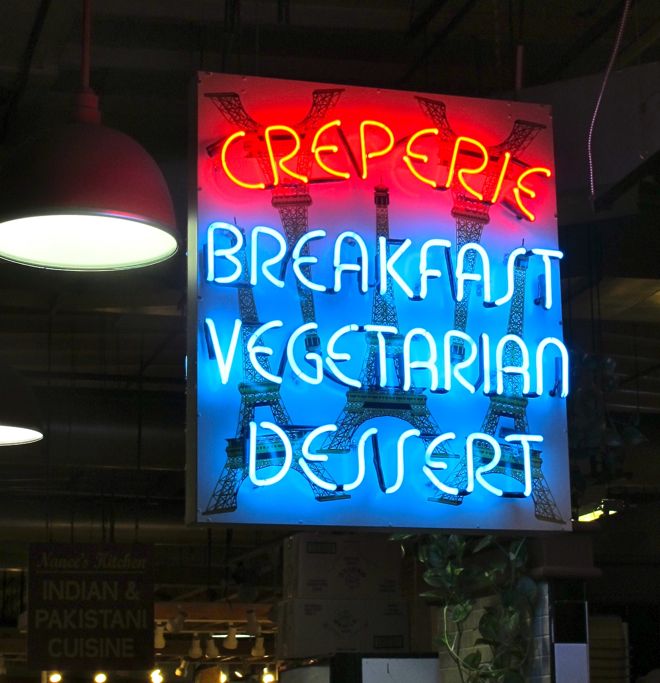
There were hitches as with all experiments, but everyone (on screen and behind the scenes providing tech support) did their utmost to make it a satisfying communal learning project. Filreis is now a confirmed advocate of collective wisdom. He’s taught Modern Poetry for 30 years, but was blown away by interpretations he’d yet to consider coming from “non academics”. He admitted to Googling people who made particularly astute remarks on forums or in essays, suspecting they were poetry ‘insiders’, only to uncover a retired engineer or high school senior.
The syllabus covered more than a century of American poetry from proto-modernist icons Walt Whitman and Emily Dickinson, through the conceptual appropriation and unoriginality practices of Kenneth Goldsmith, Christian Bok, and Tracie Morris. By week 10, re-reading Gertrude Stein poems encountered in week 4 was like rediscovering Wordsworth in a beloved anthology. In poetry as in most worthwhile endeavors, today’s shocking becomes tomorrow’s consensus.
Coursera lets you head back to school without the lifestyle upheaval it once engendered. I was able to participate in a real time course at UPenn while living on a farm in rural Touraine, traveling up and back to Paris every week as well as much further afield. The only transit and time zone snag involved participation in life webcasts. They were scheduled when I was was either traveling without a wifi connection or asleep in the wee hours of the morning.
From testimony heard in webcast sessions and read on forums, it seems I was one of thousands profoundly affected by the ten week journey. In a labor of love the carrot of grading isn’t necessary, and might have crimped the freedom of discourse and risk taking poetry demands. For the moment, completing assignments (weekly quizzes, four essays and mandatory critique of classmates’ essays) earns you a virtual gold star rather than tangible course credit. Not bad for high calibre, yet free education.
The most valuable lesson was reaffirmation that rules about language are an ever shifting construct. Poets are on the frontier of language exploration – misunderstood, ridiculed and eventually belatedly celebrated. Among the reasons poetry remains relatively uncorrupted and radical is because there’s no money in it. While the world of poetry intersects with those of visual arts, music, theater and technology, there are few corporations lining up to sponsor living poets.
So I’m back to blogging. Less conflicted about the merits of the internet.
I’d love to know what your favorite poems or poets are – so PLEASE share in comments!

Note about photos: Taken when I coincidentally visited Philadelphia in late September and discovered Reading Terminal Market. I was as taken with the crazy poetry of the signage as the fabulous range of food on offer.

In 1955 when American heiress Marjorie Merriweather Post purchased the 25 acre Hillwood Estate in Washington DC, she remodeled the house and gardens to reflect her passion for European decorative arts and landscape design. Upon her death Post bequeathed the house and collection to the public, and the museum provides a window onto the world of the original owners of the art as well as the lifestyle and taste of the woman who collected it.
The mansion’s reception rooms showcase Mrs Post’s collection of French and Russian imperial 18th and 19th century paintings and furnishings. Portraits of French and Romanov royals survey the Louis XVI furniture resplendent with marquetry and gilded brass, Sèvres porcelain, Beauvais tapestries and Fabergé eggs.
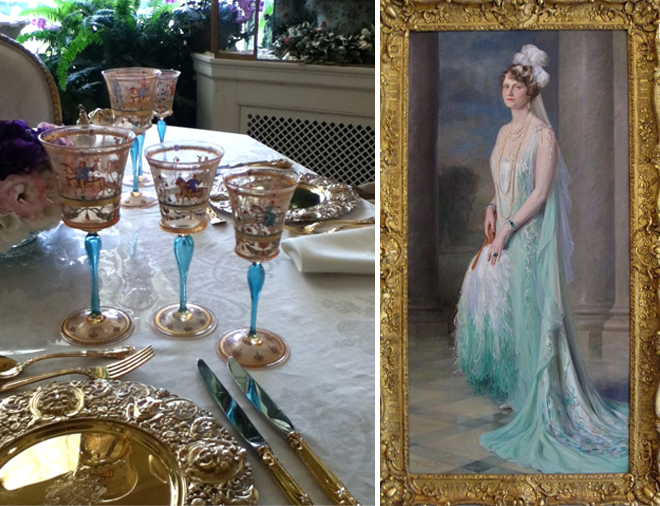
The much married heir of midwestern entrepreneur C.W. Post, founder of the Postum Cereal Company, looked to America’s eastern establishment and European aristocracy to fashion her identity and ambiance of her home. The result is a bit of an aesthetic hodgepodge. When well advised by influential art dealers like Sir Joseph Duveen, her purchases were sure, but left to her own devices she veers into pastiche. Glamour portraits by contemporary artists of she and her daughters (including hollywood actress Dina Merrill) dressed to the nines, dripping in jewelry and frippery are pretty dreadful.
When wealthy Americans try to emulate historic European homes and decor it inevitably comes off as false. The patina is missing. Not enough dust balls, worn parquet and frayed upholstery.

The real treasure at Hillwood is the kitchen and pantry. Talk about authenticity. 100% American ingenuity. Julia Child would think she’d arrived in heaven. After her father’s death, Mrs Post became involved in the family business and her second husband businessman Edward F. Hutton acquired Birdseye frozen food as part of a series of acquisitions that transformed the company into General Foods.
The kitchen and pantry are models of 1950’s modernity. Each utensil and appliance is left in place as though the staff are about to show up to prepare for the next function. For foodies and lovers of Americana it’s not to be missed.

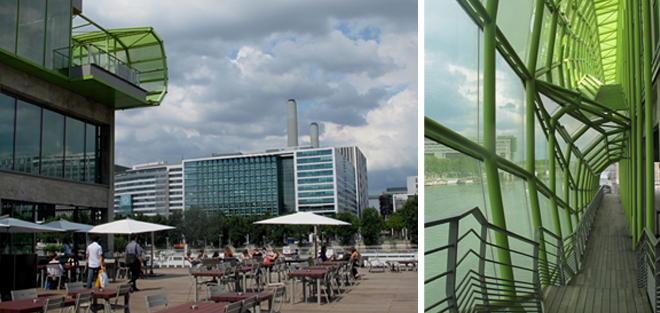
Paris has a new fashion temple on the Seine – Les Docks, Cité de la Mode et du Design – between Gare d’Austerlitz and the BNF. Another style scoop for the Left Bank’s eastern waterfront.
The undulating lime green facade is hard to miss from the opposite bank. Architects JAKOB+MACFARLANE created a diamond pattern ‘Plug-Over’ for the existing industrial dock building. Goals of the state-funded project include attracting visitors besides the fashion/design tribe, and furthering the city’s reputation as world fashion capital. Outdoor space is expansive, with wooden decks on the street and roof levels. Plenty of seating is provided for sunning, sipping drinks and surveying river traffic.
It’s an ambitious 4-story complex encompassing a museum/gallery, conference & showroom space, offices, boutiques and 4 bar/restaurants. The MoonRoof quickly became a hot RDV for drinks and celebrations. A sprawling deck surrounding the surprising vegetal roof offers spectacular river views.
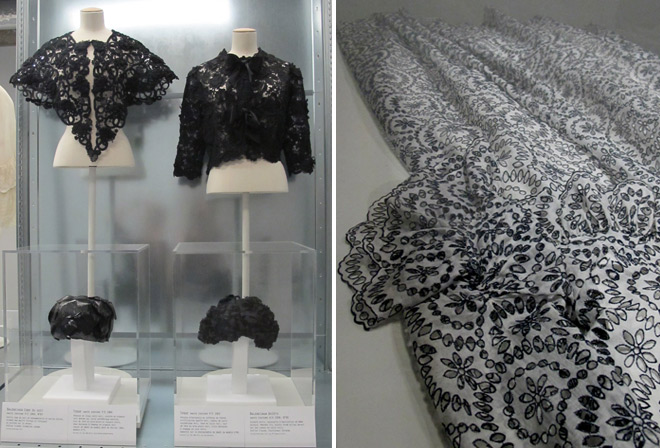
The MUSÉE GALLIERA HORS LES MURS has a duet of shows through October 7 featuring past and present couture innovators:
Cristobal Balenciaga – Collectionneur de Modes
White Drama – Rei Kawakubo for Comme des Garçons
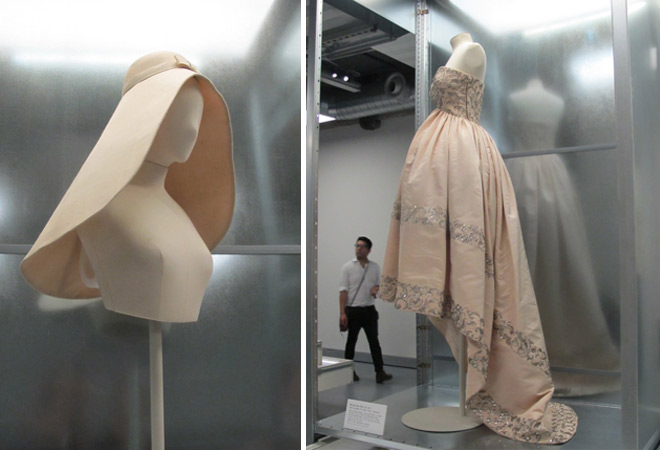
The Balenciaga exhibit marks the 40th anniversary of the Spanish couturier’s death. It showcases 40 garments created between 1937 and 1968, alongside his private collection of 18th and 19th century fashion, costumes and accessories. The juxtaposition demonstrates how folkloric costumes and 19th century fashion inspired his work. The installation is a bit disconcerting – with couture pieces on mannequins above cantilevered drawer display cases. I’d prefer seeing the gowns at ground level, visible from several vantage points. Looking up at clothing is not a flattering angle. One of several exquisite Balenciaga hats – a sweeping sculptural bridal model, was reprised in the 2012 Balenciaga spring-summer collection.
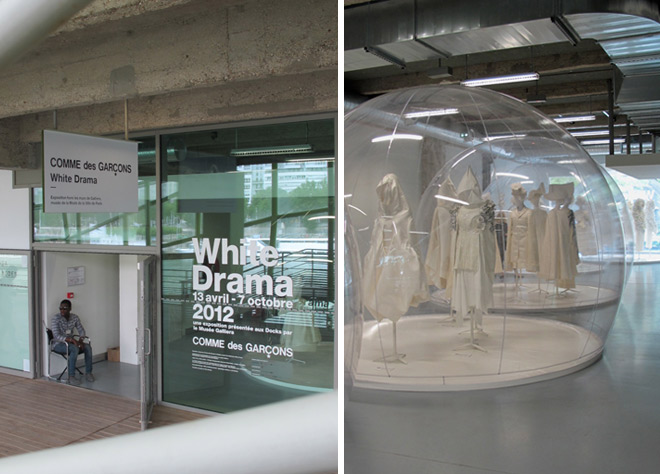
While the couturiers’ couturier leaves you with visions of black lace mantillas, the accompanying show of Rei Kawakubo’s 2012 spring-summer collection, is a blizzard of creamy white. Mannequins are grouped by theme in plastic bubble tents. The effect is eerily poetic. Her runway show received glowing reviews; a moving spiritual parenthesis amid a succession of commercial collections.
Striking parallels exist between the two exhibits – sculptural form married with decorative embellishment, solid colors versus prints, gathered seaming and substantive fabrics that imbrue garments with ceremonial solemnity.
Left feeling I’d been witness to rituals conducted by a high priest and priestess of fashion.
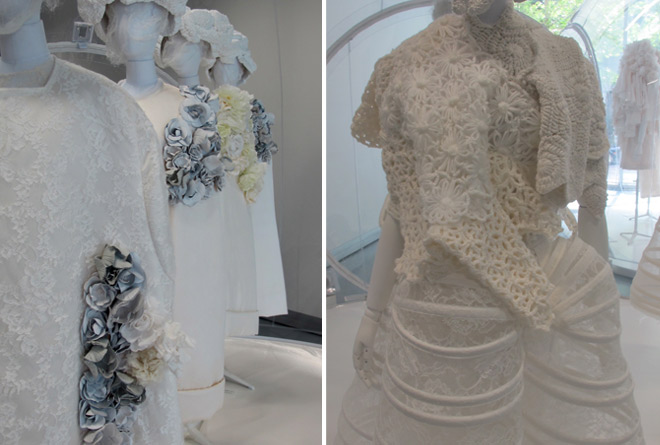
Our daughter Sarah is back from college in Manhattan, where she’s a fashion design major at Parsons.
Her summer job is selling women’s clothing and accessories in a high-end ready to wear boutique on rue St. Honoré in Paris. The other day, three women in burqas (sans outlawed niqab veil) entered the boutique.
The fact they were wearing burquas wasn’t surprising, as the sales help are accustomed to shrouded Middle Eastern clients.
Instead of browsing the racks, the woman clustered by the door fishing in their Hermès ‘Kelly’ bags.
They each pulled out a fitted transparent plastic cover, slipped it over their handbag and headed out into the rain without a word.
Sarah was miffed she didn’t capture the scene on camera. Funny how clothing intended to repel the gaze of lascivious men, throws into high relief an accessory that’s the object of intense envy among status hungry fashionistas.
Who could help but stare.
What do you think? Leave a comment below!
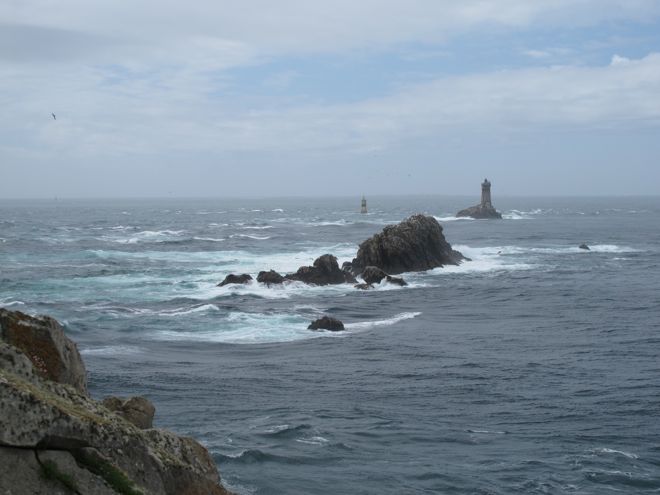
Just back from the department of Finistere on the southwest coast of Brittany. It’s a good thing the scenery is gorgeous because Brittany weather is consistently wet and windy. I did catch 2 sunny beach days at Pont-Aven one summer, but the sea was so cold it gave you a headache. If you thrive on the bracing coastal romance of Maine, Nova Scotia, west of Ireland and Scotland, then Finistere is for you.
The holy grail of windswept scenery is La Pointe du Raz, beyond the village of Plogoff – a rocky promontory notorious with sailors for intimidating waves and deadly currents. Tourists were kitted out in hiking sneakers and anoraks with a hood. It was far too blustery for an umbrella or a rain hat, unless tied tight under the chin (not a winning look even for babies).
Pointe du Raz is France’s Land’s End, and became a major tourist destination after Victor Hugo and Gustave Flaubert extolled its savage beauty. “Here is the end of the old world; behold its outer limit. Over your shoulders lie all of Europe and Asia; in front of you the ocean, the endlesss ocean.**” Technically Flaubert got it wrong, as there are two other Brittany outcroppings that extend a tad further into the Atlantic, but neither has comparably sublime scenery.
When crowds needed to be reined in at the risk of destroying the fragile ecosystem, Raz was designated a protected national park – one of France’s not-to-be-missed “Grand Sites”. Today’s pilgrimage is an orderly, didactic affair involving paid parking, a show-and-tell visitor’s center and jitney bus ride for the tired, infirm, lazy, or anyone who hopes to keep their hair looking good. On a clear day you can spy the low-lying island of Sein, just 5km offshore. Sein is a hardy fishing community with neither cars nor protected harbor, now threatened by rising sea levels. The sea was too rough for ferries to dock the day we were there.
Finistere is the cradle of Basse (or low) Brittany culture. Basse refers to the western half of Brittany, where most locals spoke only Breton before it was outlawed in 1902. An unofficial border has existed since the 14th century between the Basse and Gallo (French speaking) eastern half of Brittany. The Celtic language formerly spoken in the west, is now being revived in bilingual schools throughout the peninsula, and promoted through numerous cultural associations and institutions, yet a mere 5% of the population (206,000*) speak it fluently.
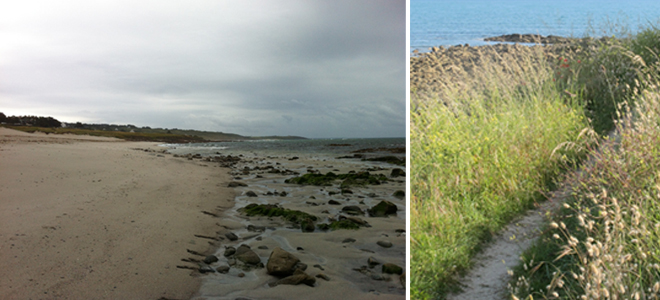
The profile of a typical Bretonnant speaker is a retired married woman with no educational degree living along the Finistere coast. Her husband was likely a fisherman, farmer or manual laborer and chances are that her children understand the language but don’t speak it. Ironically, the generation who speaks fluently is conflicted about Breton’s importance, as their parents (many of whom didn’t speak fluent French) were stigmatized as being primitive. What is now being taught in bilingual schools, and spoken on radio and TV, can be difficult for them to understand, as they speak more of a patois.
The statistical trend isn’t promising for a living language, with less than 2% of school children enrolled in bilingual school and just 3% of parents transmitting it at home. However, the reality of a language in decline hasn’t tarnished its stature as a symbol of regional pride.
We tuned into a Breton station for a few hours, and concluded that it’s unintelligible to French and English speakers. The only word I picked up was the German sounding “Ya” for yes. Breton most closely resembles Welsh, and like Wales, Bretons identify strongly with their traditions. Much of their identification is tied to a mythic past and heroic traits or stereotypes like rugged individualism and connection with nature.
Bretons describe themselves in the third person as independent characters that are stubborn, rebellious, hard working and sensitive. Having grown up in an Irish American family, I recognize the disconnect between talking the talk and walking the walk. If I’d proposed studying Gaelic instead of Latin or French, my parents would have told me to have my head examined. Speaking with a brogue was a stigma, just as having a Breton accent is tied to a lingering sense of inferiority among many elderly Bretonnants.
Unlike the Pays Basque, Brittany isn’t battling for autonomy or the sort of institutional independence Catalonia won in Spain. There’s a stronger sense of community here than in other regions of France, but also less xenophobia. Brittany voters have historically rejected the National Front party and tend to vote Socialist. While the rest of France considers the Brittany peninsula somewhat remote, Brittany has never perceived itself as isolated. The sea has always been its highway and its ports have welcomed visitors from Spain and the British Isles for centuries. It is closer to to England than Paris.

Plouhinec west of Quimper was our second Brittany filming destination. I tested Air BNB and found a modest three-bedroom house overlooking a sandy cove, down the road from the fishing port of Audierne. Stringent coastal zoning no longer permits construction close to the shoreline, but the owners of the house we rented are seeking permission to add on a needed second bathroom on the upper floor. With that addition, I would highly recommend it for two couples or a family with small children. The location, delightful view and price can’t be beat, and for those who enjoy cooking, the kitchen is well equipped. A Franco-British couple owns it and Sue the booking member of the couple and her trusty housekeeper couldn’t be more accommodating. Read More »
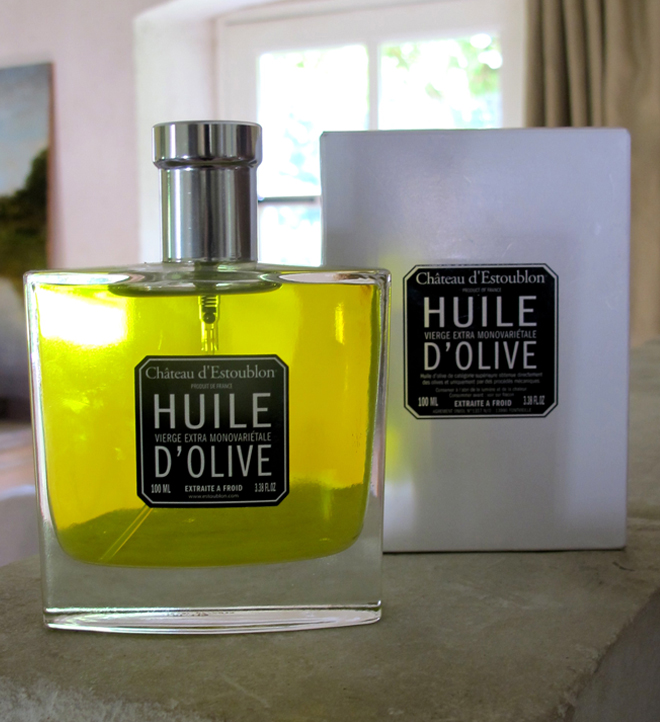
Competition in the haut olive oil category is on a par with fine wine.
Top of the line French oil is from Provence*, and one savvy producer – Chateau d’Estaublon – is carving a niche straddling the fragrance and food categories. The minimalist spray flacon and carton are inspired by Chanel perfume, and the description “hints of fresh cut grass with a slightly fervent finish” made me want to spritz it on my neck.
They suggest spraying it on vegetables, salad or fresh pasta. The flavor is light and quite delicious.
I received mine as a hostess gift from a chic Parisian woman. It is so quintessentially French that it may become my go-to-gift to bring over when visiting friends in the States.
For the moment is is distributed in the US by World Harvest Foods of Missouri, but their mark up is surprisingly steep. Must have something to do with weight of the thick glass. Best to hold off until your next visit.
*The official appellation is AOP les Baux-de-Provence.
 Frank Bruni of the NY Times hit a home run with his May 25 article “How I fell for Lisbon”.
Frank Bruni of the NY Times hit a home run with his May 25 article “How I fell for Lisbon”.
Currently an Op-Ed columnist for the paper, Bruni was it’s chief restaurant critic from 2004-2009, so a companion article “4 Lisbon Restaurants Not to Miss” is also a keeper.
I visited the city for the first time last month, staying with a French friend who moved there eight years ago. Rather than rush around visiting major sights, we opted for a narrow but deep immersion in his Amalfa neighborhood with a few forays beyond. It was an authentic introduction to a historic, working class neighborhood in the shadow of the city’s ancient castle, but I didn’t feel prepared to do justice to Lisbon in a blog post.

One significant oversight in Bruni’s piece is Fado singing – a popular genre with origins in the early 19th century that features bittersweet songs of the sea and working class heartache. It’s Portugal’s answer to country music, covering the repertoire of longing, regret, fatalism and redemption country singers do best. The singer or duet are usually accompanied by 2 guitarists on Classical and Portuguese guitars. The old Alfama neighborhood has several restaurants and bars where singers are non professional and meander from venue to venue throughout the evening, breaking hearts with a few songs before moving on to the next.
Also recommend taking a ferry across the Tagus river to Almada, to eat in one of the modest seafood restaurants patronized by locals, where the preparation is simple and the quality of fresh produce unbeatable. You can digest your meal wandering down to the end of the old wharf to admire the iconic Abril Bridge – which really is twin sister to San Francisco’s golden Gate.
Like Bruni, I arrived in Lisbon with low expectations, and left wishing I’d planned to stay longer.

Beyond broad beaches of fine sand and gently rolling waves – 3 reasons not to miss this gracious seaside town in the Médoc wine region:
Just when you’re convinced there can’t be more hidden treasure along the Atlantic coast – you hit on a sleeper like Soulac. Why didn’t I know about this place? 100 kms north of Bordeaux and a hop across the Gironde estuary from Royan – it merits better name recognition. Soulac has the architectural potential to be a mini Savannah or South Beach of the French Atlantic coast, yet remains a little known family resort.
Arriving from the north or east, the easiest way to get there is a 30-minute car ferry from Royan. Leave time for a quick tour of the city. Royan is a brilliant white-painted concrete 1950’s time capsule. The old city was obliterated on January 5, 1945 by Allied carpet-bombing intended to annihilate intransigent Nazis. A massive urban renewal project attempted to compensate for thousands of citizens killed due to tragic miscommunication between an American general and the French military concerning evacuation.
A scenic alternate route is up the peninsula via Bordeaux. The winding road along the Gironde Estuary traverses fabled Chateaux vignobles – Margeaux, Latour, Mouton-Rothschild and Lafite – ending in Saint Estèphe, before leaving the undulating Haut Médoc terroir to enter the marshy flatlands of Médoc.
The landscape is a mixture of sand dunes and scrub pines on the ocean side, and marshland along the estuary. The eastern shore is scissor cut with minute tidal ports, where modest pleasure and fishing boats keep company with cabanes de pêcheurs cantilevered over the water on stilts. The most picturesque to my taste is Port de la Maréchale next to St-Seurin-de-Cadourne.

In mid March, Soulac was emerging from winter hibernation. Its population of 3,000 expands July through August to 55,000, but tourist season builds up slowly. My first hotel choice – Hôtels des Pins in Amelie Beach at the southern edge of town – opens in April, so we settled for Hotel Michelet, a small 2 star a block off the oceanfront. The establishment is impeccably clean and professionally run, but shrill décor, circa 1995, is hard on the eyes. Imagine the decorating section of a DIY homestore like Leroy Merlin.
The Michelet’s central location, plus sea views and a balcony in chambre 10, compensated for clashing color schemes. Philippe the proprietor couldn’t be nicer or better intentioned – even going so far as to deliver a breakfast tray at seven am.
Our Lady of the Ends of the Earth is an apt name for the Romanesque Basilica nestled at the heart of town. Back when Saint Veronica (buried in the church) was proselytizing the Gironde peninsula, the former Benedictine abbey at its tip was indeed remote. Were it not for occasional passage of St. Jean de Compostel pilgrims crossing the Gironde estuary, it would have been completely ignored.
Over the centuries, Soulac fell into obscurity as the dunes encroached on the Basilica to the point of swallowing it up. By the 18th century, farmers drove metal rings into the barely protruding stone towers to attach livestock. Today, pines teetering over the edge of the sandy cliff above Amelie Dune testify to ongoing errosion, and make it possible to imagine how a monastery could be engulfed over the centuries.

In the mid 1800’s, the fashion for bathing cures accelerated development of ‘Soulac-les-Bains’, and construction began of its charming Côte d’Argent style villas. Escavation and restoration of the Basilica in 1860 brought more visitors. A second wave of villa construction followed in the early decades of the 20th century with a more idiosyncratic ‘post colonial’ vernacular featuring turrets, pavilions, jutting wings, balustrades and porches. Lacey punched wood fretwork and terracotta roof tiles were de rigor, along with brightly hued painted wood trim.
Colonnaded first floor balconies evoke the architecture of French Caribbean and African island colonies. Each villa has a romantic or sentimental name enshrined on painted tiles, carved stonework or cursive script under the peak of a central eave above the front door. Stop by the Tourism office (next door to the cinema) for times of guided tours offered in several languages.

Ten to 15 years ago, a vintage gingerbread brick villa could be had for 40 thousand euros, but now a 75 m3 cottage & garden requiring work, sells for €350M (still a bargain by Cap Ferret standards, where a characterless shack goes for significantly more). Buyers are primarily French, while tourists are German and Dutch, with a smattering of British.
On your tour of centre ville, don’t miss the handsome market building. Its cavernous hall is filled with rows of food, wine, florist and flea market stalls. A side wing is devoted to fish and seafood. Open daily year round from 8am to 1pm, and again during July & August between 5 and 8 pm.
Restaurant choices in March were limited, especially midweek, but it’s evident that plenty of variety exists for summer vactioners. Tables on the glass veranda of Le Grill Océan on the Front de Mer enjoy an idyllic view of sunset over the beach – just the place to marvel at the conjunction of Venus and Jupiter in the velvet night sky on March 13. For seafood lovers, a €25 dinner menu includes large fresh oysters or a tureen of terra cotta hued fish soup as a starter, and grilled dorade or mussels in cream sauce for the main course. Desserts are homemade. Inexpensive white Bordeaux and Côte de Gasgones on offer. A 2009 Château de Teste provided a satisfying switch from Loire Valley white. La Villa Soulacaise, also recommended by our host, was closed for dinner.
The surprise of the visit was coming upon a replica of the Statue of Liberty perched atop a pedestal at the north end of ocean drive. It arrived clandestinely in Soulac in 1941 when French rail workers intercepted a train shipping it from Bordeaux to Germany, where it was destined to be melted down for armaments. In Bordeaux the statue had been the centerpiece of a giant fountain in Place Picard, but after the war Soulac held on to her.

Following Liberty’s gaze toward the horizon, you’ll spot the iconic silhouette of Phare Cordauan. Built in 1611, it is the oldest French lighthouse in service and the last to be inhabited full time. The lavish interior includes a chapel where weddings and baptisms take place. Nicknamed the Versailles of lighthouses, Cordauan is accessible at low tide on foot from neighboring Le Verdon-sur-Mer, if you are up for a 7-kilometer hike across the sand bar.
It’s hard to project how Soulac’s genteel ambiance is affected by summer crowds. In the old town center, streets are narrow and can’t handle much car traffic. Locals I met claim it remains off the radar despite development of the huge Médoc marina complex nearby, capable of harboring large boats.
The square and adjacent sidewalks in front of the Basilica were being renovated under supervision of historic preservation, so access roads were sealed off with metal grills. I managed to squeeze through a gap in the fencing and approached a group of stonemasons to inquire if the church was open. None of them spoke French, so I tried English and one happily spoke up. Not surprisingly they were Portuguese. Sadly the church was closed but they had no problem with me wandering around and I was able to admire exceptional carved stonework at the back. Another excuse to return in warmer weather to better sample Soulac’s ample charms.
© Copyright 2025 Casey O’Brien Blondes - Privacy Policy | Design by Weller Smith Design
Do NOT follow this link or you will be banned from the site!